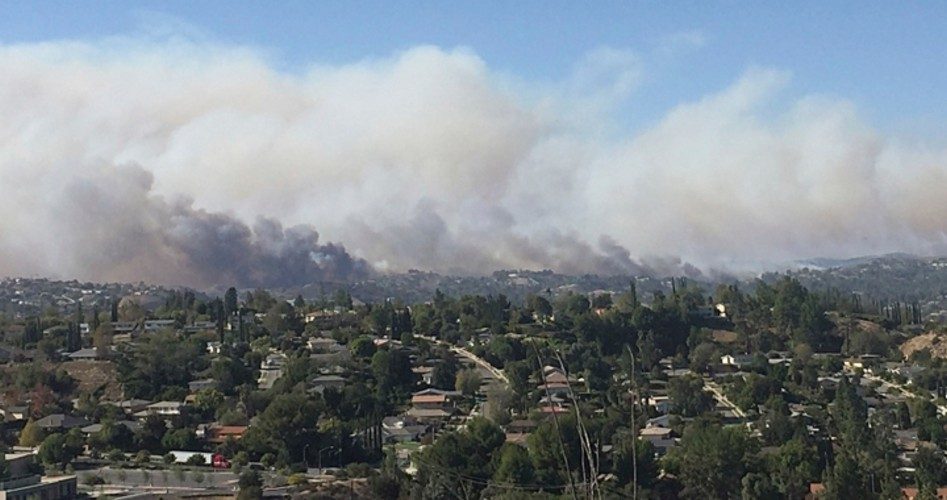
As both the Camp and Woolsey Fires in California continue to burn, the blame game rhetoric continues on as well, as unabated as the fires themselves. Outgoing Governor Jerry “Moonbeam” Brown (D) went so far as to blame the fires on “climate-change deniers,” claiming they are “definitely contributing” to the fires. Brown, a climate-change radical, called the fires a “new abnormal” because of their supposed link to man-made global warming.
As of Tuesday, Cal-Fire reports that the Camp Fire, which is raging in Northern California’s Butte County, has destroyed 125,000 acres and taken at least 42 lives. The latest incident report lists the fire as only 30-percent contained, with an expected full containment date of November 30. To date, the fire has destroyed more than 6,500 single residences, 85 multiple residences, and 260 commercial buildings. The Camp Fire is now the largest and deadliest in California history.
The Woolsey Fire, located near Los Angleles in Los Angeles and Ventura Counties, has destroyed approximately 100,000 acres and taken two lives. That incident report lists the fire as 35-percent contained with an estimated full containment date of November 18. More than 435 structures have been destroyed, with 57,000 more structures at risk. Hurricane-strength Santa Ana Winds are expected today, which will make the fires even more difficult to contain.
The cause of both of these fires is still under investigation, even though Governor Brown is blaming climate change.
{modulepos inner_text_ad}
Brown commented that last year’s fires in California represented a “new normal” in the state owing to climate change. This year, he turned up the heat on that rhetoric. “This is not the ‘new normal.’ This is the new abnormal. And this new abnormal will continue, certainly in the next 10 to 15 to 20 years.” Brown then echoed the latest United Nations’ Intergovernmental Panel on Climate Change (IPCC) report by saying, “Predictions by some scientists are we’ve already gone up one degree; I think we can expect a half a degree, which is catastrophic, over the next 10-12 years. So, we have a real challenge here threatening our whole way of life.”
Over the weekend, President Trump weighed in on the fires in California. A few hours after issuing an emergency declaration insuring federal funding for the fire-fighting effort, Trump blamed forest mismanagement for the fires and issued a warning for California to clean up the forest mismanagement or not receive federal funding.
Both Brown and Governor-elect Gavin Newsom (D) responded to the president’s threat, while at the same time pushing for him to declare a major disaster in order to ensure more funds.
Brown stuck doggedly to his “it’s all climate-change’s fault narrative,” saying, “Managing all the forests everywhere we can does not stop climate-change — and those that deny that are definitely contributing to the tragedy.”
Incoming Governor Newsom made more sense than Governor Moonbeam: “Lives have been lost. Entire towns have been burned to the ground. Cars abandoned on the side of the road. People are being forced to flee their homes. This is not a time for partisanship. This is a time for coordinating relief and response and lifting those in need up.”
Even Trump’s supporters came out against his threat to withhold funding. Republican Representative Doug LaMalfa said, “Lack of forest management has been a longtime frustration, but threats about funding when we need help isn’t going to address our dire needs or speed the process.”
While President Trump is correct in targeting forest mismanagement as a main cause of the ferocity of the current fires in California, he is wrong to lay the majority of the blame on the state. Indeed, federal bureaucracies such as the Environmental Protection Agency (EPA) and the United States Forest Service (among others) have placed so much red tape in the way of timber interests, ranchers, and recreational vehicle enthusiasts — not to mention the state and local governments — that common-sense forest management is nearly impossible not only in California, but in all states with large forested areas.
A full 20 percent of the state of California is covered by national forests — not state or private forests.
The president is asking California to remove a speck from its own eye while there is a plank in the eye of the federal bureaucracies. California can certainly do better in managing its forested and chaparral areas. But unless the federal chains are removed from their ability to do so, it won’t happen. It’s time for President Trump to more actively do what he promised us and drain some of the bureaucratic swamp in Washington, D.C.
Related articles:
California Burning: Global Warming or Federal Mismanagement?
Oregon Standoff: BLM’s “Burn ‘Em Out” Legacy — The Untold Backstory
Burning Up the West: Feds, Greens Cause Catastrophic Fires
Fueling the wildfires: California’s deadly wildfires expose federal land management policies
Photo: AP Images




